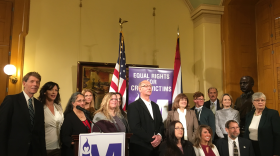Issue 1 on next week's ballot - the victim's rights measure known as Marsy's Law - is well behind the big money involved in the Drug Price Relief Act known as Issue 2. But Marsy's Law has supporters and opponents with varying concerns about it's impact. Ohio Public Radio's Karen Kasler reports.
A new ad featuring actor Kelsey Grammer is the latest in the campaign for Issue 1, also known as Marsy’s Law. It’s named for a California woman stalked and killed by her boyfriend in 1983 – her parents started the movement after they encountered her accused killer in a store, not knowing he’d been released on bail. Stacey Stevens knows what it’s like. Her father Gary was killed in a home invasion in rural Hocking County in central Ohio last year. She said those who aren’t victims of crime don’t get it.
“They don’t understand the process that you have to go through or the terrible pieces on top of the crime that was committed against my father, to then have the entire system feel like it’s weighted against me and then to protect the rights of the people who did this, and I feel like I’m just sort of voiceless,” Stevens said.
Issue 1 would put into the Constitution victims’ rights to privacy, to information about services; to notification of proceedings, release and escape of the accused; to a prompt conclusion; to refuse discovery requests; to protection and to restitution. John Murphy recently retired as head of the Ohio Prosecuting Attorneys’ Association. Murphy said Ohio law already gives victims extensive rights. But he’s concerned that the amendment would give victims legal standing in criminal cases. “This is a criminal prosecution against the defendant. We have to protect all the defendant’s rights,” Murphy said. “The victim should be heard, as they are under current law and receive notice and all of the protections we already have written into the law, but to actually be a party to the case is completely inappropriate.”
While the Prosecuting Attorneys’ Association is opposed, some individual prosecutors support Issue 1 – including Franklin County Prosecutor Ron O’Brien. He said victims should have standing. “Any prosecutor that’s doing their job and doing it right shouldn’t have any concern or fear about the victim being able to raise and be heard on some of these issues,” O’Brien said. “Currently they can be heard at sentencing and have a right to weigh in on the appropriate sentence, and all this does is put that right into some other stages of the proceeding.”
Marsy’s Law backers claim more than 350 lawmakers, officials, law enforcement and advocates supporting it, including Attorney General Mike DeWine, who’s co-chairing the campaign. There is no organized opposition with ads or flyers, but there is an interesting coalition publicly opposed to Issue 1. Besides the Prosecuting Attorneys’ Association, there’s the Ohio State Bar Association, the Ohio Association of Criminal Defense Attorneys, the American Civil Liberties Union of Ohio, and state public defender Tim Young. He said the amendment offers no remedy to victims if their rights aren’t protected. “It’s like buying a car with a warranty, but the warranty says you have no recourse against the manufacturer if it doesn’t work. What’s the point?” asked Young. “We need more resources, and there needs to be some liability when the government fails to carry out those victims’ rights. We don’t need a constitutional amendment.”
Opponents also say they’re worried about courtroom dismissals and delays, which they say could further harm victims and cost taxpayers as well. But supporters of Issue 1 say courts can easily balance the rights of victims and defendants, and cases won’t be tossed out or extensively delayed. Six other states have passed similar legislation, and Ohio is one of nine states where efforts to pass it are underway. While Issue 2, the drug price issue, has set a record for the $58 million both sides have raised, Issue 1’s supporters are the only ones bringing in money – raising just $6 million and spending nearly all of it.








